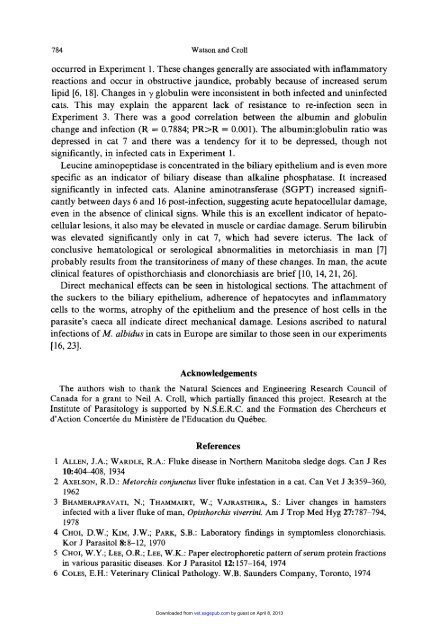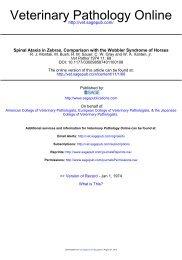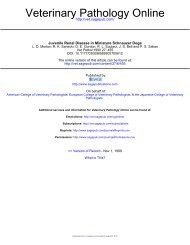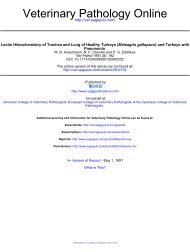Clinical Changes Caused by the Liver Fluke Metorchis conjunctus in
Clinical Changes Caused by the Liver Fluke Metorchis conjunctus in
Clinical Changes Caused by the Liver Fluke Metorchis conjunctus in
Create successful ePaper yourself
Turn your PDF publications into a flip-book with our unique Google optimized e-Paper software.
784 Watson and Croll<br />
occurred <strong>in</strong> Experiment 1. These changes generally are associated with <strong>in</strong>flammatory<br />
reactions and occur <strong>in</strong> obstructive jaundice, probably because of <strong>in</strong>creased serum<br />
lipid [6, 181. <strong>Changes</strong> <strong>in</strong> y globul<strong>in</strong> were <strong>in</strong>consistent <strong>in</strong> both <strong>in</strong>fected and un<strong>in</strong>fected<br />
cats. This may expla<strong>in</strong> <strong>the</strong> apparent lack of resistance to re-<strong>in</strong>fection seen <strong>in</strong><br />
Experiment 3. There was a good correlation between <strong>the</strong> album<strong>in</strong> and globul<strong>in</strong><br />
change and <strong>in</strong>fection (R = 0.7884; PR>R = 0.001). The a1bum<strong>in</strong>:globul<strong>in</strong> ratio was<br />
depressed <strong>in</strong> cat 7 and <strong>the</strong>re was a tendency for it to be depressed, though not<br />
significantly, <strong>in</strong> <strong>in</strong>fected cats <strong>in</strong> Experiment 1.<br />
Leuc<strong>in</strong>e am<strong>in</strong>opeptidase is concentrated <strong>in</strong> <strong>the</strong> biliary epi<strong>the</strong>lium and is even more<br />
specific as an <strong>in</strong>dicator of biliary disease than alkal<strong>in</strong>e phosphatase. It <strong>in</strong>creased<br />
significantly <strong>in</strong> <strong>in</strong>fected cats. Alan<strong>in</strong>e am<strong>in</strong>otransferase (SGPT) <strong>in</strong>creased signifi-<br />
cantly between days 6 and 16 post-<strong>in</strong>fection, suggest<strong>in</strong>g acute hepatocellular damage,<br />
even <strong>in</strong> <strong>the</strong> absence of cl<strong>in</strong>ical signs. While this is an excellent <strong>in</strong>dicator of hepato-<br />
cellular lesions, it also may be elevated <strong>in</strong> muscle or cardiac damage. Serum bilirub<strong>in</strong><br />
was elevated significantly only <strong>in</strong> cat 7, which had severe icterus. The lack of<br />
conclusive hematological or serological abnormalities <strong>in</strong> metorchiasis <strong>in</strong> man [7]<br />
probably results from <strong>the</strong> transitor<strong>in</strong>ess of many of <strong>the</strong>se changes. In man, <strong>the</strong> acute<br />
cl<strong>in</strong>ical features of opisthorchiasis and clonorchiasis are brief [lo, 14, 21, 261.<br />
Direct mechanical effects can be seen <strong>in</strong> histological sections. The attachment of<br />
<strong>the</strong> suckers to <strong>the</strong> biliary epi<strong>the</strong>lium, adherence of hepatocytes and <strong>in</strong>flammatory<br />
cells to <strong>the</strong> worms, atrophy of <strong>the</strong> epi<strong>the</strong>lium and <strong>the</strong> presence of host cells <strong>in</strong> <strong>the</strong><br />
parasite's caeca all <strong>in</strong>dicate direct mechanical damage. Lesions ascribed to natural<br />
<strong>in</strong>fections of M. albidus <strong>in</strong> cats <strong>in</strong> Europe are similar to those seen <strong>in</strong> our experiments<br />
116, 231.<br />
Acknowledgements<br />
The authors wish to thank <strong>the</strong> Natural Sciences and Eng<strong>in</strong>eer<strong>in</strong>g Research Council of<br />
Canada for a grant to Neil A. Croll, which partially f<strong>in</strong>anced this project. Research at <strong>the</strong><br />
Institute of Parasitology is supported <strong>by</strong> N.S.E.R.C. and <strong>the</strong> Formation des Chercheurs et<br />
d'Action ConcertCe du M<strong>in</strong>istere de l'Education du Quebec.<br />
References<br />
1 ALLEN, J.A.; WARDLE, R.A.: <strong>Fluke</strong> disease <strong>in</strong> Nor<strong>the</strong>rn Manitoba sledge dogs. Can J Res<br />
10404408, 1934<br />
2 AXELSON, R.D.: <strong>Metorchis</strong> <strong>conjunctus</strong> liver fluke <strong>in</strong>festation <strong>in</strong> a cat. Can Vet J 3359-360,<br />
1962<br />
3 BHAMERAPRAVATI, N.; THAMMAIRT, W.; VAJRASTHIRA, S.: <strong>Liver</strong> changes <strong>in</strong> hamsters<br />
<strong>in</strong>fected with a liver fluke of man, Opisthorchis viverr<strong>in</strong>i. Am J Trop Med Hyg 27787-794,<br />
1978<br />
4 CHOI, D.W.; KIM, J.W.; PARK, S.B.: Laboratory f<strong>in</strong>d<strong>in</strong>gs <strong>in</strong> symptomless clonorchiasis.<br />
Kor J Parasitol88-12, 1970<br />
5 CHOI, W.Y.; LEE, O.R.; LEE, W.K.: Paper electrophoretic pattern of serum prote<strong>in</strong> fractions<br />
<strong>in</strong> various parasitic diseases. Kor J Parasitol 12 157-164, 1974<br />
6 COLES, E.H.: Veter<strong>in</strong>ary <strong>Cl<strong>in</strong>ical</strong> Pathology. W.B. Saunders Company, Toronto, 1974<br />
Downloaded from<br />
vet.sagepub.com <strong>by</strong> guest on April 8, 2013
















